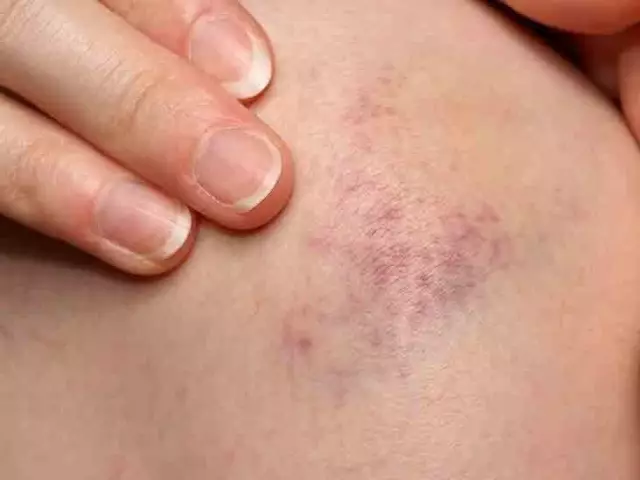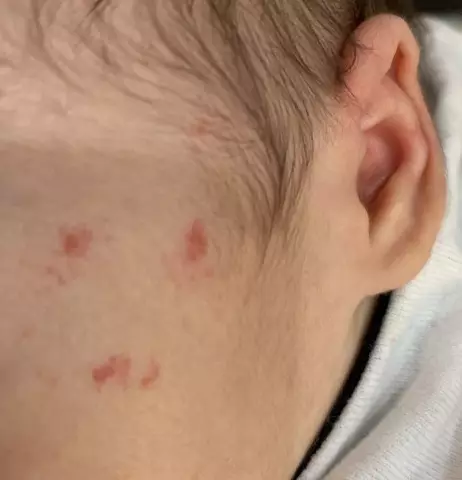- Author Rachel Wainwright [email protected].
- Public 2023-12-15 07:39.
- Last modified 2025-11-02 20:14.
Diathesis in children
The content of the article:
- Causes of diathesis in children
- Diathesis forms
-
Symptoms of diathesis in children
- Allergic diathesis
- Neuro-arthric diathesis
- Lymphatic-hypoplastic diathesis
- Diagnostics
- Treatment of diathesis in children
- Possible complications and consequences of diathesis
- Forecast
- Prevention of diathesis in children
Diathesis in children (from the Greek. Diáthesis - predisposition) is an increased reactivity of the immune system, a consequence of the congenital constitutional features of the neurovegetative system and metabolism, manifested in response to contact with an irritant.
The child's body has a number of features: the processes of digestion and absorption of nutrients in it occur differently than in adults, which is why children are so sensitive to certain foods; the highest frequency of infectious diseases is observed in young children, and infections can cause serious complications; aggressive environmental factors (medicines, household chemicals) have a stronger effect on the child's body.
Many of the diseases common in children are absent or extremely rare in adults. Diathesis refers precisely to such conditions, although it is not a disease, but a tendency of the body to a particular disease. The predisposition to diathesis in children usually manifests itself between the ages of 3 to 6 months; in most, it disappears after a few years.

Source: sovjen.ru
Causes of diathesis in children
The main role in the appearance of diathesis is played by a genetically determined feature of the organism, multiplied by the effect of environmental factors. Factors of an adverse effect on the nervous and endocrine system of metabolic products and chemicals are also provoking agents.
The conditions of intrauterine development of the fetus are also risk factors. Diathesis can result from damage to the central nervous system during childbirth or fetal hypoxia. Poor nutrition of the mother, toxicosis, smoking have a negative impact. Later - aggressive drug therapy and the nature of feeding. Typical sources of allergens are foods that have not been cooked or that remain allergenic after being cooked.

Source: online.org
Diathesis forms
There are three main forms of diathesis:
- allergic (exudative-catarrhal);
- lymphatic-hypoplastic;
- neuro-arthritic.
Allergic diathesis is a violation of the implementation of the immune response, when ordinary substances begin to be regarded by the immune system as aggressive. The destruction of tissues, including mast cells, occurs, and histamine is released during destruction. It is its non-specific release that causes inflammation, itching, swelling of the skin. An increase in immunoglobulin E (IgE) is found in the blood plasma. In the development of exudative-catarrhal diathesis, age-related characteristics of the digestive system and histamine sensitivity play the main role. The presence of allergic diseases in the family history is observed in the majority of those suffering from allergic diathesis.
Neuro-arthric diathesis is a violation of metabolic processes caused by a malfunction of the mechanisms of purine and protein metabolism. In this case, an excessive formation of uric acid occurs, the salts of which precipitate in the tissues and affect the joints, gastrointestinal tract, respiratory system, lead to endocrine disorders, inflammation of the joints, atherosclerosis, overexcitation of the central nervous system. In the blood and urine, there is a persistent increase in the concentration of purines.
The occurrence of lymphatic-hypoplastic diathesis is associated with dysfunction of the adrenal cortex. Dysfunction of the endocrine system can lead to pathology of the lymph nodes, a decrease in the function of the thymus gland. Reduces immunity and the ability to adapt to aggressive environmental factors, increases the propensity to infectious diseases and allergic reactions.
Symptoms of diathesis in children
The first clinical manifestations of allergic diathesis in a child on the cheeks can appear in the first weeks of life. The maximum manifestations fall on the age from six months to a year.
The main clinical symptom of diathesis is pruritus. As a result of scratching the itchy areas, point erosion is formed, covered with yellowish crusts, weeping areas, often their secondary infection occurs. The child has anxiety, sleep is disturbed. Sometimes the manifestations of diathesis on the face of a child can go to a part of the body, arms and legs.
In the severe course of diathesis after a year, erythematous-papular rashes, manifestations of neurodermatitis, dry eczema, stomatitis, recurrent inflammatory eye diseases, rhinitis, bronchitis (sometimes with an asthmatic component), disturbances in the work of the biliary tract and the gastrointestinal tract appear.
Symptoms of diathesis in children vary with the form of the disease.
Allergic diathesis
With allergic diathesis, there are:
- pallor, looseness, hydrophilicity, inelasticity, pastiness of the skin;
- decrease or uneven increase in body weight;
- peeling of the skin, the formation of seborrheic crusts and scales;
- the appearance of diaper rash, weeping on the body, scalp;
- hyperemia, infiltration of the skin of the cheeks;
- erythematous-papular rash, strofulus (urticaria for children);
- abdominal pain, frequent and loose stools.

Source: idermatolog.ru
Neuro-arthric diathesis
The first manifestations of neuro-arthritic diathesis in children usually arise from the nervous system, the activation of the nerve centers occurs due to the irritating effect of urates and can manifest itself in the appearance of anxiety, sleep disturbances, and outbursts of aggression.
With damage to the joints and kidneys in the early stages, there are only complaints of joint pain (more often at night). Sometimes in the early stages there are signs of damage to the digestive tract, allergic rashes.
Symptoms of the neuro-arthritic form of diathesis:
- irritability, anxiety, aggression;
- joint pain, dysuric disorders;
- migraine headaches;
- acetone vomiting, a feeling of the smell of acetone during breathing;
- convulsive syndrome;
- bronchospasm, asthma attacks;
- intestinal and hepatic colic, constipation.

Source: myshared.ru
Lymphatic-hypoplastic diathesis
This form of diathesis is formed by the second or third year of life and, as a rule, ends by puberty.
Lymphatic-hypoplastic diathesis in children has the following manifestations:
- pasty, pallor;
- lethargy, inactivity;
- short neck;
- increased size of the head, abdomen;
- decreased muscle tone;
- increased excitability of the central nervous system;
- hyperplasia of lymphoid tissue (peripheral lymph nodes, tonsils and mushroom papillae of the tongue), which leads to a hoarse voice, whooping cough in the absence of infection;
- autonomic dysfunctions, frequent SARS with symptoms of sore throat, obstructive syndrome, prolonged and persistent fever;
- hypoplasia of the cardiovascular system.

Source: myshared.ru
Diagnostics
Allergic diathesis, first of all, is diagnosed by external manifestations, laboratory tests are used to clarify the diagnosis. With this form of pathology, the concentration of eosinophils in the blood increases, the level of gamma globulins and albumin decreases, the level of cholesterol decreases, and the acid-base balance shifts towards acidosis.
During the diagnosis of neuro-arthritic diathesis, the following are prescribed:
- general and daily urine analysis, analysis to determine urine output;
- biochemical blood test with determination of the level of uric acid, urates, oxalates and phosphates, bicarbonates, buffer bases (increase in blood levels of acetone and ketone bodies, uraturia);
- blood test for pH (pH);
- blood tests for corticosteroids;
- Ultrasound of the organs of the urinary system, liver;
- radiography of the lungs.
If you suspect lymphatic-hypoplastic diathesis:
- general and biochemical blood test (lymphocytosis, decreased glucose concentration, mono- and neutrocytopenia, increased concentration of phospholipids, cholesterol);
- immunogram [decrease in immunoglobulins A, G, decrease in the concentration of B- and T-lymphocytes, increase in the concentration of circulating immune complexes (CIC), imbalance of T-helpers and T-suppressors, decreased function of the thymus gland];
- study of hormonal status;
- Ultrasound of the abdominal organs;
- X-ray examination of the thymus gland.
Lymphatic-hypoplastic diathesis must be differentiated from exudative-catarrhal diathesis, acute leukemia, mononucleosis, tuberculous lymphadenitis, and other pathologies in which lymph nodes are enlarged.
Treatment of diathesis in children
In the treatment of diathesis in children, the main role is given to strict adherence to diet and a certain lifestyle.
The main method of treating allergic diathesis in children is the identification and elimination of allergens. A hypoallergenic diet is prescribed, the intake of enzymes, antihistamines, calcium preparations, non-hormonal indifferent ointments, baths with medicinal herbs (chamomile, string) are used as local therapy. An individual vaccination schedule is developed taking into account the child's allergic status.

Source: online.org
In neuro-arthritic diathesis, salt and protein intake is limited, and a diet is prescribed to help reduce the formation of urates. Drug therapy is aimed at reducing the content of uric acid in urine and alkalizing it, stimulating diuretic and metabolic processes. They also prescribe non-steroidal anti-inflammatory drugs, hepatoprotectors, sedatives and vitamin-mineral complexes containing potassium and calcium. With acetonemic vomiting, complete starvation is shown for a day, then drinking in small portions (in severe conditions - intravenous administration) of glucose solution, saline solutions.

Source: myshared.ru
With lymphatic-hypoplastic diathesis, a diet with a predominance of vegetables, fruits, lactic acid products is recommended, with a restriction of flour products and cereals, with severe allergic manifestations, a hypoallergenic diet. Adaptogens are prescribed to increase the body's nonspecific resistance. This course is recommended to be repeated with any change in lifestyle.

Source: online.org
Possible complications and consequences of diathesis
Autoimmune processes and allergic diseases such as bronchial asthma, allergic bronchitis, allergic rhinitis, atopic dermatitis, neurodermatitis, eczema can become a complication of exudative catarrhal diathesis.
Neuro-arthritic diathesis may be complicated by arthritis, gout, urate nephropathy, urolithiasis, diabetes mellitus. With a sharp increase in the level of uric acid, an acetone crisis develops, in a severe case - with circulatory and respiratory disorders.
Complications of lymphatic-hypoplastic diathesis are the most dangerous. Against the background of this type of diathesis, severe chronic pathologies of the endocrine system, including the adrenal glands, abnormalities in the work of the cardiovascular system, which may be incompatible with life, can develop. The mortality rate in children of the first year of life suffering from lymphatic-hypoplastic diathesis is 10%.
Forecast
In most children, when contact with allergens is excluded and a special diet is followed, after two years, the immune and enzyme systems differentiate, metabolic processes stabilize, and the protective functions of the skin and mucous membranes increase. The manifestations of allergic diathesis completely disappear by the age of four.
With the timely detection of neuro-arthritic diathesis and strict observance of all the doctor's prescriptions, by about seven years or by the age of puberty, the body's reactions to stimuli are normalized.
Signs of lymphatic-hypoplastic diathesis usually disappear during puberty, most neuroendocrine disorders are compensated, but in some cases the manifestations of diathesis (thymic-lymphatic status) persist.
Prevention of diathesis in children
Prevention of diathesis in a child should be started even before his birth. During pregnancy, one should deal with the prevention and treatment of complications, observe the regimen, and monitor the diet.
It has been proven that artificial feeding can be one of the causes of diathesis. Naturally fed children suffer from allergic diathesis 5-7 times less often. Complementary feeding should be started with small amounts, introducing new foods slowly and carefully. The diet of a nursing mother should be formulated with the exclusion of allergens, spicy, smoked, spices.
In everyday life, it is recommended to use natural fabrics, non-aggressive household chemicals, acceptable for children.
General strengthening measures are effective: massage, gymnastics, hardening.
YouTube video related to the article:

Anna Kozlova Medical journalist About the author
Education: Rostov State Medical University, specialty "General Medicine".
The information is generalized and provided for informational purposes only. At the first sign of illness, see your doctor. Self-medication is hazardous to health!






